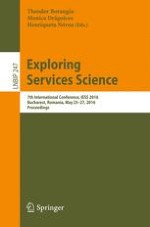This book contains the refereed proceedings of the 7th International Conference on Exploring Service Science (IESS), held in Bucharest, Romania, in May 2016.Service science constitutes an interdisciplinary approach to systematic innovation in service systems, integrating managerial, social, legal, and engineering aspects to address the theoretical and practical challenges of the service industry and its economy.
The 45 full papers and 13 short papers accepted for IESS were selected from 119 submissions. The papers consider the topics service exploration theories and processes; modeling service requirements and management of business processes; value co-creation through knowledge management and user-centric services; service design methodologies and patterns; service innovation and strategy; IT-based service engineering; servitization in sustainable manufacturing; product-service systems; business software services and data-driven service design; web service design and service-oriented agents; IoT and mobile apps for public transport service management; e-health services and medical data interoperability; and service and IT-oriented learning and education systems.
